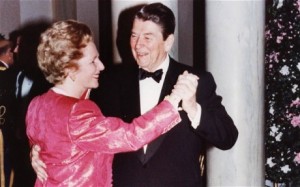REDEMPTION THREE: BETTER THAN EVER OR BETTER OFF DEAD?
In this mini-series the saga of redemption, as frequently manifested in the form of “comebacks,” is investigated. REDEMPTION ONE is here. and REDEMPTION TWO is here. Read REDEMPTION ONE before REDEMPTION THREE, inserting REDEMPTION TWO between them.

John Galliano, redeemable or not, is alive.
II. EMPIRICAL EVIDENCE
b. Better Off Dead? Two cases of Dubious Post-Mortem Redemption
As the example of time illustrates in the case of Adler, exogenous elements factor in whilst public figures are on a path towards redemption. Interestingly, the most practical way to pursue redemption might be dying. The death of a public person continues–to this day of non-secular dimensions–to make the majority of media consumers feel a predominant desire to respect their deceased status. This theory effectively extends to the redemption of some of the most controversial individuals.
MARGARET THATCHER
Margaret Thatcher’s death sparked a discourse on the very topic of the appropriateness of global media industries using unnecessary euphemisms following the passing of public figures. The mentality of “one must not speak ill of the dead” looms as a dangerous approach when it pertains to political leaders. By picking and choosing the legacy of politically-engaged people, those who pick and choose create a false record of the events that carved the lives of others.
Thatcher’s individual saga as a leadership paradigm certainly includes grand successes. She was elected thrice as the Prime Minister of the UK and was both the first female PM of the UK and first female leader of a Western country in recent history. Additionally, she actively introduced her set of conservative, nationalist political beliefs, widely known as Thatcherism.
Heated debate surrounded Thatcherism, as well as Thatcher herself. For media outlets to neglect the heavy criticism she received–and often persuasively argued against–because of her death appears callous, but also oxymoronic at its core subject, because it contradicts the nature of the person Thatcher was: a self-proclaimed “conviction politician.” Her priority was staying true to her values, despite the anticipated reaction her values would yield. It seems highly unlikely Thatcher herself would hesitate to speak ill of the dead. READ MORE >
REDEMPTION TWO: BETTER THAN EVER OR BETTER OFF DEAD?
In this mini-series the saga of redemption, as frequently manifested in the form of “comebacks,” is investigated. REDEMPTION ONE is here.
In honor of Lindsay Lohan’s birthday, REDEMPTION TWO arrives early.
II. EMPIRICAL EVIDENCE
a. Better Than Ever: Two Cases of Successful Redemption
ANTHONY WEINER
If anyone successfully gave more than enough of himself to the public, it was Anthony Weiner. With explicit twitpics some of us never saw and some of you will never forget, the former congressman’s actions led to a shameful resignation following the virtual “unfaithfulness” to his spouse, Huma Abedin[1]. Weiner did not code the public humiliation of his private life as the ending of his career. On the contrary, he interpreted, and continuously interprets, his public mistake as an opportunity for future growth and greater strength.
The married lives of politicians have always been crucial foundations to their public perception. An extensive cover interview for NYT Magazine in April depicted Weiner and Abedin’s marriage as a normal one, still recognizing the vast impact of the incident on their marriage. Particularly, the demise of the power-couple as it was in quest of a private truth–whether Weiner’s account was hacked–became the first step to achieve a private, family-based redemption. After returning to trust privately, the next challenge for the couple became reaching the redemption that would mark its return to political respectability and place Weiner’s wrongdoings in the past.
Following the scandal, Weiner’s course of action has primarily worked to his advantage, at least according to the press. He asserted that the reason he initially lied was to avoid telling Huma. Once the lie was undeniable, he owned up to his mistake by attributing it to an obscure, but under no circumstances unrealistic, cybersex habit. The fact that he did not realize the sexual acts in question, but constrained himself to the imaginary, undoubtedly ameliorated the position he found himself in following the event. READ MORE >
REDEMPTION ONE: BETTER THAN EVER OR BETTER OFF DEAD?
In this mini-series the saga of redemption, as frequently manifested in the form of “comebacks,” is investigated.
I. THEORY
a. Leadership & Empathy
The Boston bombings in April triggered a very strong emotional response from the American audience. As everyone was wondering what the circumstances and details that led to the violent actions were, the media used the usual humanizing technique it consistently has since I can recall being a part of its audience: individual sagas and personal stories were provided to increase the degree of empathy the viewers experienced.
Leaders–or individuals who desire to rise to a leadership capacity–have been cognizant of the powerful positive impact of engaging the audience’s compassion. In our epoque of suavely-impersonal communications that allude to convey a “personal” impression, the humanizing factor of public figures morphs into a vital quality. Gradually, a larger part of the audience recognizes that we often feel like we know others to a much grander depth than we actually do through their social media projections and the curated accessibility they provide. Suddenly, achieving a stronger human connection is ultimately integral in setting leaders and public individuals apart from their competitors.
The recent popular imagination has introduced a modern hierarchy in which potential leaders and public individuals become an inspiration for the masses. Rather than an alien image of perfection, the idea of the strong individual who learned from his/her mistakes seems like a newfound pattern in reaching previously unattainable levels of respect. A routine of redemptional strategies has become commonplace in helping individuals progress to higher positions. The mistakes or faults ultimately yield an advantageous result by making them more “human” and easier to identify with as authority figures. The degree of empathy they manage to garner from the audience is relative to their declaration of a new status which clearly pronounces their existence as void of their prior faults. Under such circumstances, where individuals sought change, their mistakes even add to their charisma and personality. Having demonstrated sensitivity humanizes them; being able to surpass the stigma legitimizes their leadership potential. READ MORE >



